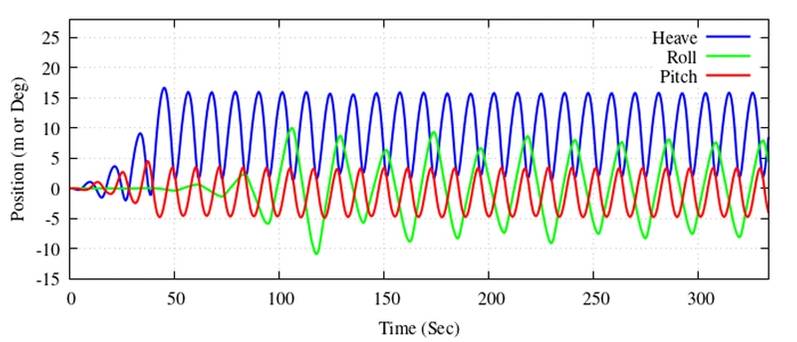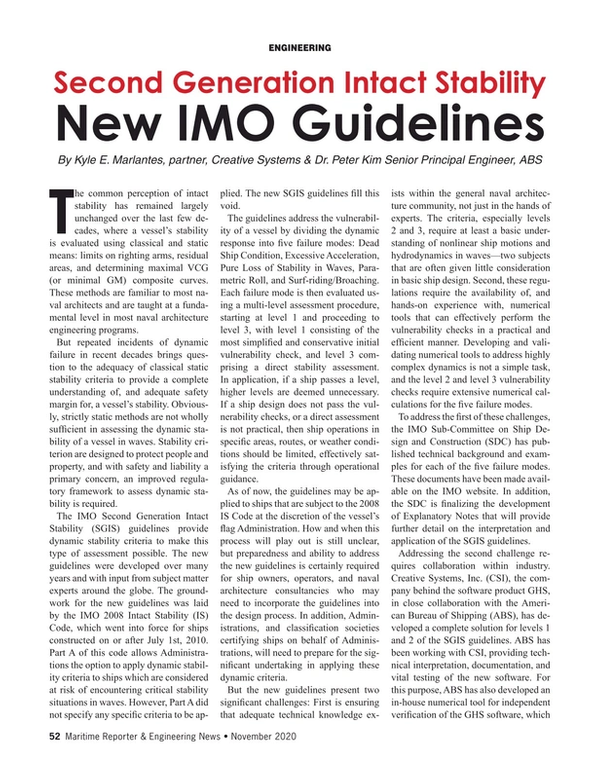
Addressing the New IMO Guidelines for Second Generation Intact Stability
The common perception of intact stability has remained largely unchanged over the last few decades, where a vessel’s stability is evaluated using classical and static means: limits on righting arms, residual areas, and determining maximal VCG (or minimal GM) composite curves. These methods are familiar to most naval architects and are taught at a fundamental level in most naval architecture engineering programs.
But repeated incidents of dynamic failure in recent decades brings question to the adequacy of classical static stability criteria to provide a complete understanding of, and adequate safety margin for, a vessel’s stability. Obviously, strictly static methods are not wholly sufficient in assessing the dynamic stability of a vessel in waves. Stability criterion are designed to protect people and property, and with safety and liability a primary concern, an improved regulatory framework to assess dynamic stability is required.
The IMO Second Generation Intact Stability (SGIS) guidelines provide dynamic stability criteria to make this type of assessment possible. The new guidelines were developed over many years and with input from subject matter experts around the globe. The groundwork for the new guidelines was laid by the IMO 2008 Intact Stability (IS) Code, which went into force for ships constructed on or after July 1, 2010. Part A of this code allows Administrations the option to apply dynamic stability criteria to ships which are considered at risk of encountering critical stability situations in waves. However, Part A did not specify any specific criteria to be applied. The new SGIS guidelines fill this void.
The guidelines address the vulnerability of a vessel by dividing the dynamic response into five failure modes: Dead Ship Condition, Excessive Acceleration, Pure Loss of Stability in Waves, Parametric Roll, and Surf-riding/Broaching. Each failure mode is then evaluated using a multi-level assessment procedure, starting at level 1 and proceeding to level 3, with level 1 consisting of the most simplified and conservative initial vulnerability check, and level 3 comprising a direct stability assessment. In application, if a ship passes a level, higher levels are deemed unnecessary. If a ship design does not pass the vulnerability checks, or a direct assessment is not practical, then ship operations in specific areas, routes, or weather conditions should be limited, effectively satisfying the criteria through operational guidance.
As of now, the guidelines may be applied to ships that are subject to the 2008 IS Code at the discretion of the vessel’s flag Administration. How and when this process will play out is still unclear, but preparedness and ability to address the new guidelines is certainly required for ship owners, operators, and naval architecture consultancies who may need to incorporate the guidelines into the design process. In addition, Administrations, and classification societies certifying ships on behalf of Administrations, will need to prepare for the significant undertaking in applying these dynamic criteria.
But the new guidelines present two significant challenges: First is ensuring that adequate technical knowledge exists within the general naval architecture community, not just in the hands of experts. The criteria, especially levels 2 and 3, require at least a basic understanding of nonlinear ship motions and hydrodynamics in waves—two subjects that are often given little consideration in basic ship design. Second, these regulations require the availability of, and hands-on experience with, numerical tools that can effectively perform the vulnerability checks in a practical and efficient manner. Developing and validating numerical tools to address highly complex dynamics is not a simple task, and the level 2 and level 3 vulnerability checks require extensive numerical calculations for the five failure modes.
 A typical nonlinear time domain response generated using GHS to assess the Parametric Roll Level 2 Failure Mode for a C11 containership in head seas. Image Courtesy Creative Systems/ABS
A typical nonlinear time domain response generated using GHS to assess the Parametric Roll Level 2 Failure Mode for a C11 containership in head seas. Image Courtesy Creative Systems/ABS
To address the first of these challenges, the IMO Sub-Committee on Ship Design and Construction (SDC) has published technical background and examples for each of the five failure modes. These documents have been made available on the IMO website. In addition, the SDC is finalizing the development of Explanatory Notes that will provide further detail on the interpretation and application of the SGIS guidelines.
Addressing the second challenge requires collaboration within industry. Creative Systems, Inc. (CSI), the company behind the software product GHS, in close collaboration with the American Bureau of Shipping (ABS), has developed a complete solution for levels 1 and 2 of the SGIS guidelines. ABS has been working with CSI, providing technical interpretation, documentation, and vital testing of the new software. For this purpose, ABS has also developed an in-house numerical tool for independent verification of the GHS software, which is widely used by ABS for the evaluation of the 2008 IS code criteria for ABS-classed ships.
The direct assessment (level 3) presents a considerable challenge to designs that fail levels 1 and 2. A level 3 analysis is not something that can be carried out quickly, as the numerical demands are quite substantial, and physical testing presents rigid cost and scheduling limitations. A natural question, then, is how will level 3 typically be assessed? A recommended design practice is a sequential application of the criteria such that, if levels 1 and 2 fail, then level 3 or operational guidance will be required. Also note that the determination of operational guidance based on either a probabilistic or deterministic approach would require model tests or numerical simulations equivalent to level 3. In this regard, ABS continues to develop and validate a numerical tool for level 3. Recently, ABS participated in the Dynamic Stability “DYNASTY” working group of the Cooperative Research Ships (CRS) joint industry project to conduct model testing and validate numerical tools for level 3.
Also, a simplified approach for the preparation of operational guidance using the level 1 and level 2 criteria would be acceptable. From the ABS’s perspective, the numerical tool for level 2 criteria will play an important role in the assessment of ship designs and also in the determination of operational guidance or limitations, as needed. Introducing level 1 and level 2 capabilities in GHS is therefore a critical step in providing the necessary numerical tools to address the new guidelines.
The new IMO SGIS guidelines truly bring intact stability assessments into a new generation. In years past, ship dynamics were often not a primary concern, or simply a rudimentary consideration in the design process. Under the new guidelines, the complexity and effort required by a level 3 assessment or preparation of operational guidance will make it prudent to develop designs that pass the first two levels. Therefore, the new guidelines will bring a change in the design process: requiring the consideration of ship dynamics as early as possible.
Read Addressing the New IMO Guidelines for Second Generation Intact Stability in Pdf, Flash or Html5 edition of November 2020 Maritime Reporter
Other stories from November 2020 issue
Content
- Engineering Ethics, Seaworthiness and the Right of Clients to Kill Themselves page: 14
- Cavotec, ASKO Power Forward on Autonomous, Zero-Emission Fleet page: 32
- Wilson Sons: Inside Brazil’s Workboat Goliath page: 36
- Addressing the New IMO Guidelines for Second Generation Intact Stability page: 52
- Interview: Rear Admiral John Okon, Commander, Naval Meteorology and Oceanography Command, US Navy page: 70


